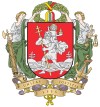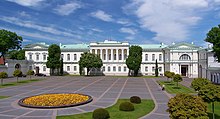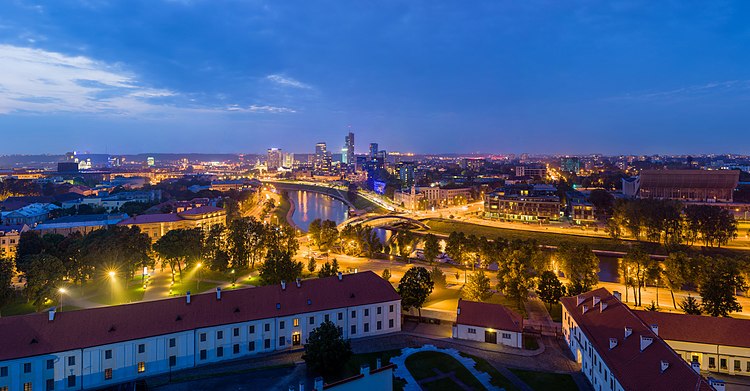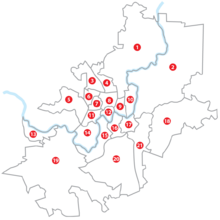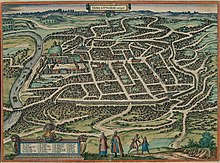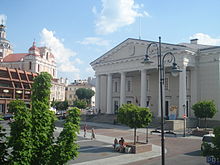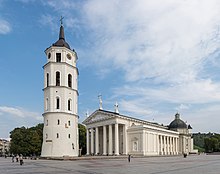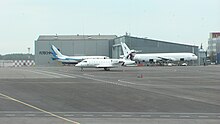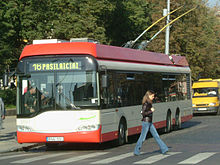Vilnius
| Vilnius | |||
|
|||
| State : |
|
||
| District : | Vilnius | ||
| Municipality : | Vilnius | ||
| Founded : | 1323 | ||
| Coordinates : | 54 ° 41 ′ N , 25 ° 16 ′ E | ||
| Height : | 112 m | ||
| Area (place) : | 401 km² | ||
| Inhabitants (place) : | 574,221 (2017) | ||
| Population density : | 1,432 inhabitants per km² | ||
| Time zone : | EET (UTC + 2) | ||
| Telephone code : | (+370) 5 | ||
| Postal code : | 01001-14191 | ||
| Status: | City, town charter since 1387 | ||
| Structure : | 21 Seniūnijos ("offices") | ||
| Mayor : |
Remigijus Šimašius |
||
| Website : | |||
|
|
|||
Vilnius [ ˈvʲɪlʲɲʊs ] ( German Vilnius , polish Vilnius , Russian Вильнюс Wilnjus , belarusian Вільня Wilnja , yiddish ווילנע Wilne ), is the capital of Lithuania . With 574,221 registered inhabitants (2017), Vilnius is the most populous city in the country and with an area of 401 km² the largest city in the Baltic States . It belongs to the municipality of Vilnius and, along with the VMSA administration, is also its administrative seat.
Vilnius is the seat of the Catholic Archdiocese of Vilnius and with the Vilnius University founded in 1579 one of the oldest university cities in Europe. In 2009 it was named European Capital of Culture together with the City of Linz .
Vilnius was founded by the Baltic from the beginning and, unlike the capitals of the neighboring Baltic countries, Riga in Latvia and Tallinn in Estonia , was never controlled by the Teutonic Order . As the capital of Lithuania, it developed into the center of an extensive empire which, at the height of its power around 1618, as Poland-Lithuania, temporarily extended from the Baltic Sea to the Black Sea.
Since its founding, Vilnius has been considered one of the most liberal cities in Europe. a. offered protection to the persecuted Jews from Central Europe and Russia. As the “Jerusalem of the North”, Vilnius became the center of Jewish culture and enlightenment. Around 1900, Lithuanians made up only a small part of the population (2%), after Jews (40%), Poles (30%) and Russians (20%). As a result of the Second World War , the city lost the majority of its residents (Poles were expelled and Jews fled or were murdered in the Holocaust ) and was practically repopulated by Lithuanians and Russians afterwards . This completely changed the social structure of Vilnius.
From the 16th century, Italian builders created numerous baroque buildings in the city. The old town of Vilnius is one of the largest in Eastern Europe and was declared a UNESCO World Heritage Site in 1994 . Because of the more than 50 churches in the city, Vilnius is also known as the " Rome of the East".
In a ranking of cities according to their quality of life, Vilnius ranked 81st out of 231 cities worldwide in 2018.
name of the city
The city is known by different names according to its multiethnic and multicultural character. European maps and descriptions used the name Wilna or Vilna from the 14th to the 20th centuries . The oldest documented forms from the 14th century are vor die Wilne , ante Vilnam or similar. In Lithuanian it is called Vilnius , and this name - first documented around 1600 - is gradually becoming established in other languages as well.
The name of the city is derived from that of the Vilnia river (often called Vilnelė in diminutive ), which flows into the Neris not far from the historical city center on Gediminas Hill . The Lithuanian words vilnìs and vilnelė mean "wave" and "small wave" respectively. An alternative name of the Neris is also * Velija , documented around 1230 as Велья . The name of the smaller tributary was originally a diminutive of this name.
The asteroid (3072) Vilnius is named after the city.
Function as capital

In addition to its current function, Vilnius also had a historical one, with a varied course as the capital. From 1569 to 1795 it was the capital of the Lithuanian Grand Duchy in the Polish-Lithuanian aristocratic republic Abiejų Tautų Respublika (Poland-Lithuania or Republic of Two Nations).
With the third partition of Poland and Lithuania both completely lost their independence and Vilnius lost its previous capital city function, which the city received again only in 1945, apart from a break from 1918 to 1922. When it was incorporated into the Russian Empire during the partition , Vilnius became the administrative headquarters of the Lietuvos Generalgubernatorija (Lithuanian General Government) from 1795 to 1830 and then from 1830 to its dissolution in 1912 the Vilniaus Generalgubernatorija (Vilnius Generalgouvernement). Within the two general governorates , the city also functioned as the central administrative seat of the respective Gubernia , whose name and geographical location changed several times, in which Vilnius was located, e.g. B. the Vilniaus gubernija (Vilnius Gubernia / Gouvernement).
After Lithuania regained independence ( see ↑ Independence since 1918 ), Vilnius became the capital of the first Lietuvos TSR (Lithuanian SSR) from 1918 to 1919, the Lietuvos – Baltarusijos TSR ( Lithuanian – Belarusian SSR ) in 1919 , and from 1920–1922 of the Litwa Środkowa / Vidurinė Lietuva state (Central Lithuania).
From 1922 to 1945 Vilnius (apart from 1940 to 1941) was not the capital of a Lithuanian state, but again an administrative seat at the provincial level, this time in Poland or under German occupation. In detail, the city was the capital of the voivodeship of the same name in the II Rzeczpospolita (Second Polish Republic) from 1922 to 1939 , from 1940 to 1941 the capital of the second Lietuvos TSR (Lithuanian SSR), from 1941 to 1945 the capital of Vilnius Land in the Reichskommissariat Ostland and after 1945 again capital of the re-established Lietuvos TSR until 1990.
geography
location
The city is located in a wooded hilly landscape in southeast Lithuania at the confluence of the Vilnia and Neris, around 40 km from the Belarusian border. The geographical center of Europe is located north of Vilnius in the village of Purnuškės .
climate
The climate in Vilnius is temperate continental. In the mostly short warm summers, peak values of over 35 ° C were measured. The lows in winter were below -37 ° C. The warmest summer month is July, the coldest winter month is January. The annual amount of precipitation between 1961 and 1990 averaged 683 millimeters per year. The monthly data can be taken from the climate diagram.
| Vilnius | ||||||||||||||||||||||||||||||||||||||||||||||||
|---|---|---|---|---|---|---|---|---|---|---|---|---|---|---|---|---|---|---|---|---|---|---|---|---|---|---|---|---|---|---|---|---|---|---|---|---|---|---|---|---|---|---|---|---|---|---|---|---|
| Climate diagram | ||||||||||||||||||||||||||||||||||||||||||||||||
| ||||||||||||||||||||||||||||||||||||||||||||||||
|
Average monthly temperatures and rainfall for Vilnius
Source: wetterkontor.de
|
|||||||||||||||||||||||||||||||||||||||||||||||||||||||||||||||||||||||||||||||||||||||||||||||||||||||||||||||||||||||||||||||||||||||||||||||||||||||||||||||||||||
City structure
The Vilnius district is one of ten counties in Lithuania. The largest and most populous district in terms of area is in the southeast of the country and also includes the capital Vilnius. On July 1, 2010, the district administrations ( apskrities administracija ) in Lithuania were deleted as administrative units without replacement.
The municipality of Vilnius consists of the following 21 districts with different numbers of districts. It is the only city council in Lithuania that manages two cities (Vilnius and Grigiškės ) and three villages of Grigiškės.
|
1. Verkiai |
7. Viršuliškės |
13. Grigiškės |
19. Paneriai |
history
Legend has it that Gediminas , the Grand Duke of Lithuania since 1316, stopped while hunting on a hill at the confluence of the Neris and Vilnia rivers. There he dreamed of an iron wolf that " howled loudly like a hundred wolves ". The arrow he fired at the animal ricocheted off its steel body. Worried, he asked his pagan high priest Lizdeika for the interpretation of this episode: “What the gods have granted the ruler and the Lithuanian state may happen: the iron wolf stands on a hill on which a castle and a city will be built - the capital Lithuania and the residence of the rulers. "The fortress must be as solid as iron, then its fame would echo loudly through the world (The Lithuanian words for loud and famous are identical)." At that time, the Trakai moated castle to the west was the seat of the Ruler.
Beginnings

According to archaeological studies, the area of the city was already settled in the Stone Age Magdalenian . Other sites in the urban area have been dated to the 4th millennium and the 2nd century BC. In the early Middle Ages, this tactically advantageous place was first settled by Balts, later Slavs and, from the 11th century, Jews too. As early as the 10th century, a wooden fortification was built in what is now the city, around which a settlement was built. Vilnius was first mentioned in historical sources as the capital of the Lithuanians in 1323. In that year Grand Duke Gediminas sent letters written in Latin to the emperor, the pope, various orders of knights and trading cities of that time. In it he recruited merchants, scientists and craftsmen for " in civitate nostra regia, Vilna dicta " - as highly qualified guest workers and attracted two churches, including freedom of religion. This tolerance towards the most varied of faiths was to determine the development of the city for a long time to come, but it also repeatedly made it the target of warlike attacks by the Teutonic Order, each of which was accompanied by devastation of the city and its surrounding area, for example in 1365, 1375, 1377, 1383, 1390 , 1392, 1394 and 1402.
Poland-Lithuania
Since the Teutonic Order, with its urge to expand in the Baltic States, had threatened both the Grand Duchy of Lithuania and the Kingdom of Poland since the middle of the 13th century , the Lithuanian Grand Duke Jogaila decided to enter into an alliance with Poland. As a result of the Union of Krewo in 1386, he married the Polish Queen Hedwig . The country was reformed and Christianized. The "eternal fire" on the hill of Vilnius was extinguished and the pagan temple was destroyed.
In 1387 Vilnius was granted Magdeburg city rights .
From the 15th century onwards, the city experienced a long period of economic and cultural prosperity, while its gradual polonization took place at the same time. In the 16th century it developed into the center of organ music , in 1579 the University of Vilnius was founded on the basis of the Jesuit college (Alma academia et universitas Vilnensis societatis Jesu). At the same time, Vilnius became the most important center of Jewish culture in Northern Europe and was nicknamed the Jerusalem of the North . The 17th century was marked by wars, fires and epidemics and was devastating for the population and the building fabric of the city. The Russian occupation of 1655–1661 and the occupation by Swedish troops in the Great Northern War in 1702 and 1707 are considered to be particularly destructive. The great city fires of 1610, 1737, 1745 and 1747 also devastated Vilnius considerably.
Russian Empire
After the partition of Poland-Lithuania , Vilnius belonged to the Russian Empire from 1795 . It was sacked by French troops during the Russian campaign in 1812 . As a result of the Russian repression after the failed 1831 uprising, the university was closed and the city was downgraded to a provincial Russian governorate capital. In 1862 the Petersburg – Warsaw railway was opened. Although shaped by the Polish-speaking population, Vilnius, with its ancient cultural tradition, became the center of Belarusian national life in the 19th century , even before Minsk. The most important Belarusian poets and writers published their works here, and in 1906 the first Belarusian newspaper “ Naša Niva ” was published. In 1896 the businessman Straschun bequeathed his book collections to the Jewish community and thus founded the largest Jewish library in Europe. By 1900 Vilnius was one of the largest Jewish cities around and 41% of its inhabitants were Jews.
First World War and the interwar period
In September 1915 Russian troops evacuated Vilna , on September 18 German troops occupied the city. They occupied Vilna until 1918.
In 1918 the Lithuanian state with the capital Vilnius was proclaimed with German support . It was occupied alternately by the Red Army and Polish troops during the Polish-Soviet War .
With the Treaty of Versailles and the Lithuanian-Soviet peace treaty of Moscow of 1920, Lithuania and its capital Vilnius were recognized internationally. In October 1920, Polish troops re-occupied the city, including the mostly Polish-speaking southeast of Lithuania. In 1922, Poland formally added the Vilnius area to its national territory, which led to great tensions between the two countries. The Polish annexation was de facto recognized by the League of Nations . For 19 years Kaunas became the “temporary capital” of Lithuania, and Vilnius became the capital of a Polish voivodeship . The proportion of the Lithuanian population in Vilnius at that time was very low (approx. 2%), with a proportion of 53% Poles and 41% Jews. Even today, around 18% of residents call themselves Poles, and in the Vilnius area the Poles make up the majority.
The Vilnius City Mental Health Center was established in 1927.
Second World War


According to the Hitler-Stalin Pact , Poland was divided between the National Socialist German Reich and the Soviet Union.
After the start of the Second World War on September 1, 1939 with the German invasion of Poland , the Red Army invaded Poland on September 17 , as agreed in the pact . Vilnius was occupied on September 19th. On October 10th, the city was handed over to Lithuania by the Soviet Union. A good six months later - on June 15, 1940 - the Soviet Union invaded Lithuania, the country was annexed to the Soviet Union , and on August 3, 1940, Vilnius became the capital of the Lithuanian Soviet Socialist Republic . Around 35,000 Polish residents were deported to Siberia .
The German occupation of Lithuania lasted from June 23, 1941 to July 13, 1944. Vilnius became part of the Reichskommissariat Ostland . In the old town, a ghetto was set up in two parts, one of which was dissolved by October 1941 by the shootings in the Paneriai forest (about 10 km west of the city). The second ghetto existed until 1943, but gradually shrank after numerous so-called actions . The remaining Jews were deported to concentration camps and murdered there. Around 100,000 Jewish residents lost their lives. You can read more about the fighting in July 1944 here (Vilnius had been declared a “fortress” ). After 1944 the prisoner of war camp 195 for German prisoners of war was established in the city .
Lithuanian SSR and Republic of Lithuania
After the Second World War, the Polish population was expelled and Vilnius became the capital of the Soviet Socialist Republic of Lithuania. Post-war Stalinism not only brought about the nationalization and sovietization of the economy, but also tried to suppress the national and religious identity of the Lithuanians. For example, churches in Vilnius were also used as warehouses and the ruins of the former Great Synagogue were even removed. Public life was determined by strict censorship.
The Lithuanian population in Vilnius increased significantly - among other things due to rural exodus as a result of the forced collectivization of Lithuanian agriculture. In addition, the Soviet authorities encouraged the influx of workers from other parts of the Soviet Union in the first few years after the war. However, the Politburo of the Lithuanian Communist Party managed to limit the settlement of non-Lithuanians, so that the proportion of the Russian-speaking population remained at around 20 percent, while in the other two Baltic capitals, Riga and Tallinn, it temporarily rose to 50 percent.
Even after regaining independence in 1990, Vilnius remained the seat of the Lithuanian parliament and government. Today's Vilnius developed from a Soviet to a western-cosmopolitan city within ten years. On the banks of the Neris, opposite the old town and the center (development around the central Gediminas Prospect from the turn of the century), a modern office and business district has emerged in recent years, making Vilnius a magnet not only for tourists want. So far the development has been more or less on fallow land, but in the foreseeable future the poor wooden house settlements that adjoin immediately to the north will have to give way.
religion
There are a variety of churches and religious sites in the city. For several centuries there was a peaceful coexistence of the Jewish and Christian religious followers. As "Yerushalayim de Lita" (Eng. Jerusalem of the North ) Vilnius became a center of Jewish culture and enlightenment. With the advance of the German troops of the Wehrmacht to Lithuania in 1941, the end began Jewish history in Vilnius. During the Second World War, the city lost almost all of its Jewish residents and thus half of its population due to the Holocaust. Because of the war damage, the Great Synagogue was demolished in the 1950s . Today the Choral Synagogue is the only remaining Jewish sacred space in Vilnius.
Residents
In 2017 there were officially 574,221 inhabitants or 22% of the population of Lithuania in Vilnius, 54.43% of them Lithuanians, 18% Poles and 13% Russians, the remainder is spread over another 125 nationalities, 66% of the inhabitants were Catholic.
In 2016, 7,500 new registrations were made, of which 1,655 in Verkiai and 1,000 each in Naujoji Vilnia , Pašilaičiai and Antakalnis . In the polyclinics and other health facilities, 622,543 or 48,000 inhabitants more than officially registered with the registration office (2017). According to the Vilnius City Council, the municipality would receive 17 million euros more income tax if these residents were officially registered in Vilnius.
Population development
| Change in ethnic groups in Vilnius 1897–2012 | |||||||||||||
|---|---|---|---|---|---|---|---|---|---|---|---|---|---|
| year | Lithuanians | Poland | Russians | Jews | Belarusians | Other | total | ||||||
| 1897 | 3.131 | 2.0% | 47,795 | 30.1% | 30,967 | 20.0% | 61,847 | 40.0% | 6,514 | 4.2% | 10,792 | 6.9% | 154,532 |
| 1931 | 1,579 | 0.8% | 128,600 | 65.5% | 7,400 | 3.8% | 54,600 | 27.8% | 1,700 | 0.9% | 4.166 | 2.1% | 196.345 |
| 1959 | 79,400 | 34.0% | 47,200 | 20.0% | 69,400 | 29.0% | 16,400 | 7.0% | 14,700 | 6.0% | 236.100 | ||
| 2001 | 318.510 | 57.5% | 104,446 | 18.9% | 77,698 | 14.1% | 0.5% | 22,555 | 4.1% | 30,695 | 5.5% | 553.904 | |
| 2012 | 63.2% | 16.5% | 12.0% | ? | 3.5% | 4.8% | 535.631 | ||||||
| year | Pop. |
|---|---|
| 1796 | 17,500 |
| 1818 | 33,600 |
| 1859 | 58,200 |
| 1875 | 82,688 |
| 1897 | 154,500 |
| 1909 | 205,200 |
| 1919 | 128,500 |
| 1923 | 167,400 |
| 1931 | 195,100 |
| 1939 | 209,400 |
| 1941 | 270,000 |
| 1944 | 110,000 |
| 1959 | 236.100 |
| 1970 | 372.100 |
| 1985 | 544,400 |
| 2001 | 542.287 |
| 2006 | 541.824 |
| 2009 | 546.733 |
| 2011 | 542.932 |
| 2017 | 574.221 |
At the first census in the Russian Empire in 1897, of the 154,500 inhabitants of Vilnius:
- 61,847 Jews (40.0%),
- 47,795 Poles (30.1%),
- 30,967 Russians (20.0%),
- 6,514 Belarusians (4.2%),
- 3,131 Lithuanians (2.0%) and
- 10,792 other ethnicity (6.9%).
According to the census carried out by the German war administration, 19 years later (1916) there were 138,794 inhabitants in Vilnius, including:
- 74,466 Poles (53.7%),
- 57,516 Jews (41.5%),
- 2,909 Lithuanians (2.1%),
- 2,219 Russians (1.6%),
- 611 Belarusians (0.5%),
- 880 Germans (0.6%) and
- 193 (0.1%) others.
As a result of the war, the population had decreased slightly overall, mainly due to the departure of over 90% of Russians. The number of Poles, on the other hand, rose by over 60% compared to 1897, and that of Jews by just under 20%. The Poles were now the largest group ahead of the Jews.
In the Polish interwar period, a census was carried out 15 years later (1931). The population had increased to 195,100, of which:
- 65.5% Poland,
- 27.8% Jews,
- 3.8% Russians and only
- 0.8% Lithuanians and
- 0.9% Belarusians.
The total number of Jews had fallen slightly for the first time to 54,500.
The Second World War resulted in a complete population exchange. Most of the Jews who lived in Vilnius until 1939 died in the Holocaust . A large part of the Polish population was expelled into the German eastern territories now administered by Poland, while many Poles still live in the area around Vilnius to this day. The displaced Vilniusers were replaced by Russians and other Lithuanians in order to use them there in the interests of state reasons to convert the city into the capital of a Soviet Socialist Republic in Lithuania. Administrative structures and large industrial plants were established, and Vilnius experienced rapid growth. In the 1959 Soviet census, of the 236,100 inhabitants, the nationality was:
- 79,400 Lithuanians (34%),
- 69,400 Russians (29%),
- 47,200 Poles (20%),
- 16,400 Jews (7%) and
- 14,700 Belarusians (6%).
After the collapse of the Soviet Union and Lithuania declared independence, the population decreased from over 576,000 (1989) to 541,000 (2011).
In 2001 a Lithuanian census was carried out in Vilnius, according to which 57.5% of the population were Lithuanians, 18.9% Poles, 14.1% Russians, 4.1% Belarusians, only 0.5% Jews and 5.5% % other ethnicity. The majority of the Jews who remained in the 1950s had emigrated.
Politics and administration
City council
The term of office of the 51-member city council is four years. The council was elected from the lists of candidates of the registered parties until 2010. Since 2011, independent candidates can also be elected. At its first meeting, the council elects a mayor, four deputy mayors and an administrative director.
mayor
The current mayor Remigijus Šimašius was elected mayor for the first time in a direct election in March 2015.
administration
The Vilnius Municipality Administration is a municipal body that serves the Municipality Council. It helps the city council carry out its functions and assists it in its activities. The administration has over 1,100 employees (as of 2016).
City arms
The city's coat of arms dates from 1330. It shows the patron saint of Vilnius on a red background. Saint Christopher wades through a river and carries the baby Jesus on his shoulders. The baby Jesus blesses with one hand and holds the globe in the other hand. The motto is Unitas, Justitia, Spes ( Latin : unity, justice, hope)
Town twinning
According to its own information, Vilnius maintains city partnerships with the following cities:
-
 Aalborg ( Denmark )
Aalborg ( Denmark ) -
 Almaty ( Kazakhstan )
Almaty ( Kazakhstan ) -
 Brussels Capital Region ( Belgium )
Brussels Capital Region ( Belgium ) -
 Chicago ( USA , Illinois )
Chicago ( USA , Illinois ) -
 Chișinău ( Moldova )
Chișinău ( Moldova ) -
 Dnipro ( Ukraine )
Dnipro ( Ukraine ) -
 Donetsk (Ukraine)
Donetsk (Ukraine) -
 Duisburg ( Germany ), since 1985
Duisburg ( Germany ), since 1985 -
 Edinburgh ( United Kingdom )
Edinburgh ( United Kingdom ) -
 Erfurt (Germany), since 1972
Erfurt (Germany), since 1972 -
 Gdansk ( Poland )
Gdansk ( Poland ) -
 Guangzhou ( China )
Guangzhou ( China ) -
 Irkutsk ( Russia )
Irkutsk ( Russia ) -
 Joensuu ( Finland )
Joensuu ( Finland ) -
 Kiev (Ukraine)
Kiev (Ukraine) -
 Krakow (Poland)
Krakow (Poland) -
 Madison, Wisconsin (USA)
Madison, Wisconsin (USA) -
 Minsk ( Belarus )
Minsk ( Belarus ) -
 Moscow (Russia)
Moscow (Russia) -
 Nur-Sultan (Kazakhstan)
Nur-Sultan (Kazakhstan) -
 Oslo ( Norway )
Oslo ( Norway ) -
 Pavia ( Italy )
Pavia ( Italy ) -
 Palermo (Italy)
Palermo (Italy) -
 Piraeus ( Greece )
Piraeus ( Greece ) -
 Reykjavík ( Iceland )
Reykjavík ( Iceland ) -
 Riga ( Latvia )
Riga ( Latvia ) -
 St. Petersburg (Russia)
St. Petersburg (Russia) -
 Salzburg ( Austria ), since 1989
Salzburg ( Austria ), since 1989 -
 Stockholm Province ( Sweden )
Stockholm Province ( Sweden ) -
 Strasbourg ( France )
Strasbourg ( France ) -
 Taipei ( Republic of China (Taiwan) )
Taipei ( Republic of China (Taiwan) ) -
 Tallinn ( Estonia )
Tallinn ( Estonia ) -
 Tbilisi ( Georgia ), since 2009
Tbilisi ( Georgia ), since 2009 -
 Warsaw (Poland)
Warsaw (Poland)
Not all of these cities call Vilnius a twin city for their part.
Vilnius is also a member of the Federation of European Napoleonic Cities .
Culture and sights

Starting from the castle hill, the street network of the old town of Vilnius to the west and south forms a fan-like structure. The old town, which stretches up the slopes on the left bank of the Neris, has an area of 360 hectares and is one of the largest and best preserved in Europe; since 1994 it has been a UNESCO World Heritage Site. As the political center of the Grand Duchy of Lithuania from the 13th to the end of the 18th century, Vilnius had a profound influence on the cultural and architectural development of Eastern Europe. Despite some raids and destruction, many notable buildings from the Baroque, Classicism, Gothic and Renaissance periods, as well as the medieval urban structure, have been preserved.
Very few buildings were lost to fighting during World War II, but over a hundred synagogues were systematically destroyed.
Buildings
Old town
- Ruins of Gediminas Castle on the hill of the same name from the 14th and 15th centuries
- Grand Princely Palace at the foot of the castle, reconstruction (2002–2013) of the renaissance building that was demolished at the beginning of the 19th century
- Classicist Roman Catholic St. Stanislaus Cathedral next to the reconstructed castle, with a free-standing bell tower
- St. Francis Church of the Bernardine Monastery , a three-aisled brick- Gothic hall church
- St. Anne's Church , a unique example of the Flamboyant style outside of France
- Choral synagogue , the only one of the 105 synagogues left before the Second World War
- the baroque university complex with the Johannes Church (lit. Šv. Jonų ).
- Baroque Casimir Church (lit. Šv. Kazimiero ), dedicated to the national saint
- old town hall, recently rebuilt in classicist style
- Orthodox Cathedral of the Assumption of the Mother of God , dates back to the 14th century, got its current shape in the 19th century.
- Catholic Holy Spirit Church
- Gate of Dawn ( Polish Ostra brama / Lithuanian Aušros vartai ).
Outside the old town
- Catholic St. Peter and Paul Church (lit. Šv. Petro ir Povilo ), a masterpiece of the Baroque.
- Catholic St. Stephen's Church
- orthodox St. Michael and Constantine
- Rasų cemetery , where numerous prominent Lithuanians and Poles are buried. Józef Piłsudski's heart is buried here.
- the central market on the north bank of the Neris.
- The district of Užupis (German: Behind the river ) on the right bank of the Vilnele river has been transformed from a neglected and neglected corner into an artists' quarter (in the immediate vicinity of the art academy "Dailės akademija") and is now an exquisite address.
- Europa Tower , the tallest skyscraper in the entire Baltic region
Lost buildings
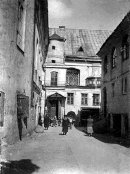
- Great synagogue in the style of the Italian Renaissance and Rococo
- 103 more synagogues
Museums
and other
Vicinity of Vilnius
A modern sight is the television tower , which is 326 m high and has a viewing platform at 190 m.
About 30 km west of Vilnius is Trakai , the medieval capital of Lithuania, with its rebuilt moated castle .
North of Vilnius in the village Purnuškės is the Europa Park . This is where the geographical center of Europe ( lit. Europos centras ) should be. However, this calculation by French scientists around 1989 is controversial due to the questionable weighting of islands. Other geoscientists place the center in Ukraine near the border with Slovakia , and there is no mandatory methodology for determining such a point.
Events and sports
The Vilnius Marathon has been held annually in Vilnius since 2001 .
Economy and Infrastructure
Vilnius is the most important administrative and economic center in Lithuania. Important banks and numerous representatives of global companies are located in the city. The most important companies include Bitė Lietuva , one of the largest telecommunications companies in the Baltic States, and Omnitel , the largest Lithuanian mobile operator, as well as Lietuvos energija , a state-controlled energy supplier and Lietuvos Gelezinkeliai , the largest railway company in Lithuania. The NASDAQ OMX Vilnius is the only stock exchange in Lithuania. It was founded in 1993 and is managed by the OMX stock exchange group. The company GEALAN Fenster-Systeme from Oberkotzau in Upper Franconia ( Germany ) has one of its four locations in the city where window profiles are produced.
traffic
The Lithuanian capital is in a kind of “dead corner” due to its proximity to the strongly secured EU external border with Belarus. The most important traffic flows from the Baltic States to the rest of the EU pass through Kaunas . From there, an expressway leads to Vilnius, 100 kilometers away. Many new roads are being built outside the city with the aim of relieving the roads within the city.
railroad
The Vilnius Railway Station is the main passenger station in the Lithuanian railway network. In addition to local and regional traffic, there is also long-distance traffic. International traffic, whose main destinations are Moscow and Saint Petersburg , are primarily served by the corridor trains on the Russia - Kaliningrad Oblast and Kaliningrad - Belarus / Ukraine route . There are also rail connections abroad in the direction of Warsaw (via Šeštokai ) and Minsk . Within Lithuania, the Lietuvos Gelezinkeliai runs its trains to Kaunas and via Šiauliai to Klaipėda .
Local stations are: Vilnius Railway Station , Station Paneriai , Station Pavilnys , Naujoji Vilnia railway station and the breakpoint Oro uostas (airport).
Long-distance transport
Long-distance buses run from the central bus station to all neighboring countries and many other countries in the European Union . An intercity bus operated by the Polish railway company Polskie Koleje Państwowe ran from the Vilnius bus station to Warsaw until 2011 . In addition, smaller Lithuanian cities are served from Vilnius.
Air traffic
In the immediate vicinity of the city is the Vilnius International Airport . In the German-speaking area, Munich, Frankfurt / Main, Vienna, Berlin, Bremen, Karlsruhe, Nuremberg and Dortmund are served.
Streets
An expressway leads to Kaunas , from there a motorway to the Baltic Sea to the ferry port Klaipėda , as well as a motorway to Panevėžys , each with a connection to Via Baltica (European route 67). There are trunk road connections to nearby Belarus and Poland.
Transportation
Local public transport is mainly served by buses and trolleybuses , as Vilnius has neither a subway nor a tram . The Vilnius trolleybus system is one of two such systems in Lithuania. The buses are mainly operated by the company Vilniaus viešasis transportas . It currently offers 69 bus routes and 22 trolleybus routes . In addition, there used to be the Maršrutka , called minibuses as regular taxi , which often served the same lines as the city buses, but which were run by private companies. A first tram line was planned in 2005 - the realization is questionable. The Lietuvos Gelezinkeliai operates a modest S-Bahn -like system of suburban trains. A metro project for the Vilniaus metro was proposed to reduce traffic jams .
Trafi (mobility app)
The Trafi mobility app for smartphones has been used in Vilnius since September 2017 . This application from a Lithuanian start-up company enables its users to choose between several alternatives for means of transport and routes through the Lithuanian capital in real time. He can centrally book and pay for all means of transport available in the city. The resulting movement data is anonymized and used by the city administration for traffic planning and its improvement.
Shopping centers
In Vilnius there are the following shopping centers and department stores:
- Akropolis shopping and entertainment center (109,000 m²) and Ozas (both in Šeškinė ),
- Gariūnai Market (80,000 m²),
- Panorama LT (65,000 m²) in Saltoniškės,
- PC Europe (Šnipiškės), Ogmijos prekybos miestas , Mada (Viršuliškės), Parkas Outlet , GO9 (in the old town of Vilnius),
- VCUP etc.
education
Vilnius University
The University of Vilnius ( Vilniaus universitetas, VU ) goes back to a Jesuit college opened in 1569, which was elevated to an academy by Stephan Báthory in 1579 on the occasion of his election as Grand Duke of Lithuania. Vilnius University is the oldest university in the Baltic States . (The oldest university in Central Europe is Charles University in Prague .) It is opposite the Presidential Palace .
YIVO
In 1925 the YIVO (Yidisher visnshaftlekher institut) was founded in Vilnius . The YIVO was the first academic institution to study Yiddish and Eastern Jewish culture. In 1940, given the circumstances of the time, it moved its headquarters to New York, where it still exists today.
European Humanistic University
In June 2005 the European Humanist University of Belarus (where it was closed in 2004 for political reasons) relocated to Vilnius, where it is run as a temporary university in exile . It is a private university and offers European, linguistic and political sciences.
ISM University of Management and Economics
The ISM University of Management and Economics was founded in 1999 by the Norwegian School of Management BI , making it the first private university in Lithuania. It is a business school and accordingly specializes exclusively in economics. The ISM maintains a campus in Vilnius and one in Kaunas.
Other universities
Vilnius also has the Gediminas Technical University in Vilnius , the Mykolas Romer University , the Lithuanian University of Education and the Kazimieras Simonavičius University . In addition, the Polish University of Białystok operates a branch in the city, where members of the Polish minority can study in Polish .
Other universities
The other universities are: the Academy of Arts Vilnius , the Lithuanian Academy of Music and Theater , the International School of Law and Business , the Business College Vilnius , the Design College Vilnius , the General Jonas Žemaitis Military Academy of Lithuania , the College of Engineering , the College of Technologies and design , the College of Vilnius , the cooperative college Vilnius , the St. Joseph seminary Vilnius and Vilnius University International Business School .
sons and daughters of the town
It lists people who were born, died or are buried in Vilnius and who have a personal connection with the city.
- Mark Matwejewitsch Antokolski (1843–1902), Jewish-Russian sculptor
- Laura Asadauskaitė-Zadneprovskienė (* 1984), pentathlete and gold medalist
- Yemima Avidar-Tchernovitz (1909–1998), Israeli children's book author
- Laima Balaishite (* 1948), table tennis player
- Grischa Barfuss (1917–1995), German writer and theater director
- Salvijus Berčys (* 1989), chess player
- Laura Bauer (* 1989), Austrian handball player
- Algis Čaplikas (* 1962), politician
- Tadeusz Chmielewski (1941–2012), Polish pianist and music teacher
- Daniel Chwolson (1819–1911), Russian orientalist and archaeologist
- César Cui (1835–1918), Russian composer and music critic
- Ingeborga Dapkūnaitė (born 1963), actress
- Remy Filipovitch (1946–2018), jazz musician and composer
- Eduard Robert Flegel (1852–1886), traveler to Africa
- Gaon of Vilna (1720–1797), Jewish scholar
- Zehava Gal-On (* 1956), Israeli politician
- Romain Gary (1914–1980), French writer
- David Geringas (* 1946), cellist
- Marija Gimbutas (1921–1994), archaeologist
- Hirsch Glik (1922–1944), Yiddish poet and partisan in World War II
- Jerzy Godziszewski (1935–2016), Polish pianist and music teacher
- Josef Grigulewitsch (1913–1988), Soviet agent, diplomat and historian
- Jascha Heifetz (1901–1987), violinist
- Kazimiera Iłłakowiczówna (1892–1983), Polish poet and translator
- Feliks Janiewicz (1762–1848), Polish composer and violinist
- Gintaras Januševičius (* 1985), pianist
- Waldemar Jochelson (1855–1937), Russian anthropologist, ethnographer and linguist
- Leo Jogiches (1867-1919), Polish-Jewish politician
- Lina Kačiušytė (* 1963), sports official and former swimmer
- Old Kacyzne (1885–1941), Yiddish writer and photographer
- Raphael Kalinowski (1835–1907), Polish Carmelite, saint
- Rimantas Kaukėnas (born 1977), basketball player
- Wiktor Każyński (1812–1867), Polish composer
- Tadas Kijanskas (* 1985), football player
- Andrius Kubilius (* 1956), politician, Prime Minister of Lithuania
- Joachim Lelewel (1786–1861), Polish historian (buried in Vilnius)
- Andrius Mamontovas (* 1967), songwriter, musician
- Rasa Leleivytė (* 1988), cyclist
- Remigijus Merkelys (* 1964), composer
- Vytautas Miškinis (* 1954), choir director and composer
- Onutė Narbutaitė (* 1956), composer
- Arno Nadel (1878–1943), German-Jewish musicologist, writer and painter
- Arvydas Novikovas (* 1990), football player
- Andreas Johannes Orlovius (1735–1788), Polish physician
- Jerzy Passendorfer (1923–2003), Polish director
- Józef Patkowski (1929–2005), Polish composer, musicologist and teacher
- Józef Piłsudski (1867–1935), Polish politician (buried in Vilnius)
- Emilia Plater (1806–1831), Polish national heroine
- Daniel Prenn (1904–1991), German tennis and table tennis player
- Ingrida Radzevičiūtė (* 1974), German handball player
- Anton Radziwiłł (1775–1833), Polish and Prussian politician, composer
- Gintaras Rinkevičius (* 1960), conductor
- Ryszard Ronczewski (* 1930), Polish actor
- Piotr Rytel (1884–1970), Polish composer, music teacher and critic
- Andrew Victor Schally (* 1926), Polish-American physiologist
- Alexander Schneider (1908–1993), violinist
- Deividas Šemberas (* 1978), football player
- Esther Shalev-Gerz (* 1948), Israeli artist
- Ingrida Šimonytė (* 1974), economist and politician
- Piotr Skarga (1536–1612), Polish Jesuit, first rector of the University of Vilnius
- Andrius Skerla (* 1977), football player
- Maximilian Steinberg (1883–1946), Russian composer
- Aaron Isaakowitsch Sundelewitsch (1853 / 54–1923), Russian revolutionary
- Abraham Sutzkever (1913–2010), writer, survivor and witness of the Vilna Ghetto
- Władysław Syrokomla (1823–1862), Polish poet
- Ivan Trutnew (1827–1912), Russian painter, founder of the Vilna School of Painting
- Michael Tschesno-Hell (1902–1980), screenwriter and cultural functionary of the GDR
- Valdas Tutkus (* 1960), Lithuanian lieutenant general
- Darius Zagorskis (* 1969), chess player
- Audronė Žigaitytė-Nekrošienė (* 1957), composer, music pedagogue, critic and journalist
literature
in the order in which they appear
Cityscape and city guide
- Salman Schneur, Hermann Struck : Wilna. Hasefer, Berlin-Charlottenburg 1924.
- Herbert Kirrinnis : Wilna. In: Journal of Geography. 1944.
- Tomas Venclova : Vilnius. City-guide. Paknio, Vilnius 2002, ISBN 9986-830-64-8 .
- Cornelius Hell : The iron wolf in the baroque labyrinth. Awakening Vilnius. Picus, Vienna 2009, ISBN 978-3-85452-951-4 .
history
- Janusz Dunin-Horkawicz: Wilna - lost homeland. Memories of a Polish Librarian (1933–1945) (= Small Historical Series, Vol. 11). Laurentius Verlag, Hannover 1998, ISBN 3-931614-94-8 .
- Joachim Tauber , Ralph Tuchtenhagen : Vilnius. Little history of the city. Böhlau, Cologne 2008, ISBN 978-3-412-20204-0 (focus on political history).
- Martin Schulze Wessel , Irene Götz , Ekaterina Makhotina (eds.): Vilnius. History and memory of a city between cultures . Campus, Frankfurt 2010, ISBN 978-3-593-39308-7 .
Jewish history of the city and the Holocaust
- David E. Fishman: Taken from Fire. The rescue of Jewish cultural treasures in Vilnius. German-Yiddish edition. Laurentius, Dehmlow 1998, ISBN 3-931614-97-2 .
- Sima Skurkovitz: Sima. Report by a Jewish woman from Vilnius about the time of the Nazi terror. C. Weihermüller, Leverkusen 2002, ISBN 3-929325-05-5 .
- Vincas Bartusevičius, Joachim Tauber , Wolfram Wette (eds.): Holocaust in Lithuania. War, murder of Jews, and collaboration in 1941 . With the participation of Ralph Giordano . Böhlau, Cologne 2003, ISBN 3-412-13902-5 .
- Kim Priemel: On the verge of the Holocaust. The rescue of Jews by members of the Wehrmacht in Vilnius . In: Zeitschrift für Geschichtswwissenschaft , vol. 52 (2004), pp. 1017-1034.
- Sem C. Sutter: The Lost Jewish Libraries of Vilna and the Frankfurt Institute for Research on the Jewish Question . In: James Raven (Ed.): Lost Libraries. The Destruction of Great Book Collections since Antiquity . Basingstoke, NY, 2004, pp. 219-235.
- Benjamin Anolik: Run to the gate my son. From Vilna through the Vilna ghetto and six camps in Estonia (= Edition Shoáh & Judaica, Vol. 3). Hartung-Gorre, Konstanz 2005, ISBN 3-86628-020-3 .
- Genrich Agranovskij: Vilnius: Memorable Sites of Jewish History and Culture . Vilna Gaon Jewish State Museum, Vilnius 2005, ISBN 9955-9556-6-X .
- Gudrun Schroeter: Words from a destroyed world. The Vilna ghetto . Röhrig Universitätsverlag, St. Ingbert 2008, ISBN 978-3-86110-448-3 (dissertation, FU Berlin 2007).
- Abraham Sutzkever : Wilner Ghetto 1941–1944 . Translated by Hubert Witt . Ammann, Zurich 2009, ISBN 978-3-250-10530-5 .
- Elke-Vera Kotowski , Julius H. Schoeps (eds.): Vilne, Wilna, Wilno, Vilnius. A Jewish topography between myth and modernity. Hentrich & Hentrich, Berlin 2017, ISBN 978-3-95565-204-3 .
Vilnius in literature
- Czesław Miłosz : The streets of Vilnius . Translated by Roswitha Matwin-Buschmann, Carl Hanser, Munich 1997, ISBN 3-446-18945-9 .
- Tomas Venclova: Vilnius. A city in Europe . Translated by Claudia Sinnig. Suhrkamp (= Edition Suhrkamp, 2473), Frankfurt am Main 2006, ISBN 3-518-12473-0 .
Web links
- Official website of the city of Vilnius (Lithuanian, English)
- Illustration of the city 1581 in Civitates orbis terrarum by Georg Braun
- Searching for traces of Jewish history - the Vilnius ghetto
Individual evidence
- ↑ While in the other Baltic capitals Riga and Tallinn Gothic ( brick Gothic ), Hanseatic and Lutheran architecture predominated and the bourgeoisie, engaged in maritime trade, predominated, in Vilnius Catholicism and the Baroque were defining and the rural trade the state-supporting class.
- ↑ Mercer's 2018 Quality of Living Rankings. Retrieved August 18, 2018 .
- ↑ wetterkontor.de
- ↑ Tauber / Tuchtenhagen (2008), p. 15.
- ↑ Tauber / Tuchtenhagen (2008), pp. 16 f., 21 f. and 33.
- ↑ Magocsi, P. R. (2002): Historical Atlas of Central Europe. Seattle: University of Washington Press
- ↑ Casimir Hermann Baer : Der Völkerkrieg, Volume 12, p. 232. Hoffmann Verlag, Stuttgart , accessed on September 17, 2010
- ^ Georges Scelle : La situation juridique de Vilna et de son territoire. Étude sur le différend polono-lithuania et la force obligatoire de la décision de la Conference des Ambassadeurs du 15 mars 1923 . In: Revue générale de droit international public , vol. 35 (1928), pp. 730-780.
- ↑ Maschke, Erich (Ed.): On the history of the German prisoners of war of the Second World War. Verlag Ernst and Werner Gieseking, Bielefeld 1962–1977.
- ^ Volker Hagemann: Riga • Tallinn • Vilnius. Tours through the metropolises of the Baltic States . Berlin: Trescher 2008, p. 218
- ↑ Miestų gyventojų tautinė sudėtis . National composition of the urban population.
- ↑ [1]
- ↑ г. Вильна Demoscope Weekly: Первая всеобщая перепись населения Российской Империи 1897 г.
- ↑ Der Große Brockhaus 1935, p. 348
- ↑ Timothy Snyder, The Reconstruction of Nations , pp. 92-93, 2003 New Haven & London, Yale University Press, ISBN 978-0-300-10586-5
- ↑ Vilnius Regional Statistical Office ( Memento of the original from April 17, 2012 in the Internet Archive ) Info: The archive link was inserted automatically and has not yet been checked. Please check the original and archive link according to the instructions and then remove this notice.
- ↑ Statistics Department of Lithuania ( page no longer available , search in web archives ) Info: The link was automatically marked as defective. Please check the link according to the instructions and then remove this notice.
- ↑ Employee statistics ( Vilnius Municipality Administration )
- ↑ Vilnius website , accessed March 4, 2015
- ↑ Unesco entry No. 541 accessed on May 15, 2011
- ↑ [2]
- ↑ [3]
- ↑ In his novel Éducation européenne (English: A european education , German General Nachtigall , Diana Verlag 1962), written in 1945, Gary erects a memorial to the Jewish partisans in the woods around Vilna from 1940 to 1943. Although fictitious, the precise plot is obviously based on actual events, information that Gary may have received from Polish representatives in exile while he was stationed as a fighter pilot in the London area
- ↑ Sutzkever also wrote for Vilnius newspapers since 1934, he was a campaigner of the Fareinict Partisan Organization . 1945 to 1947 he wrote several long poems and other texts about the ghetto in Yiddish, e. Partly translated into German
- ↑ Review at hsozkult.de, accessed on April 19, 2017.
